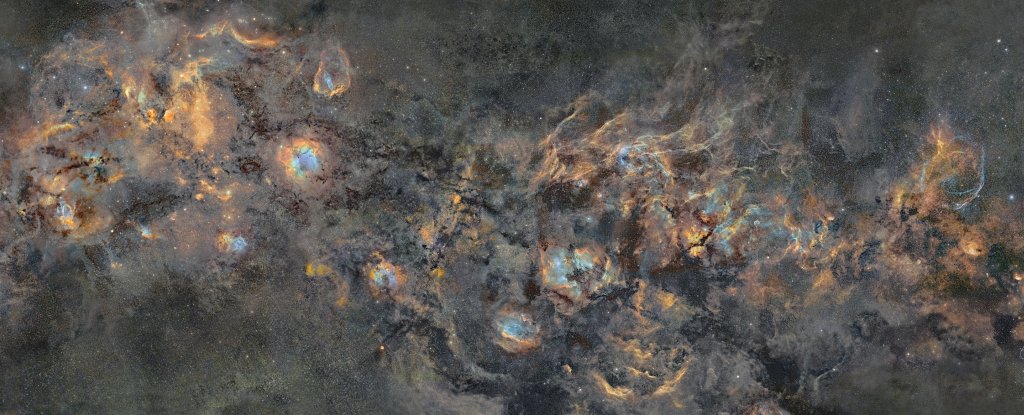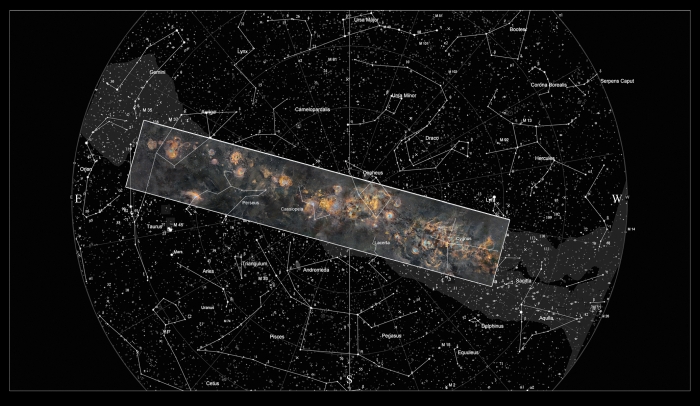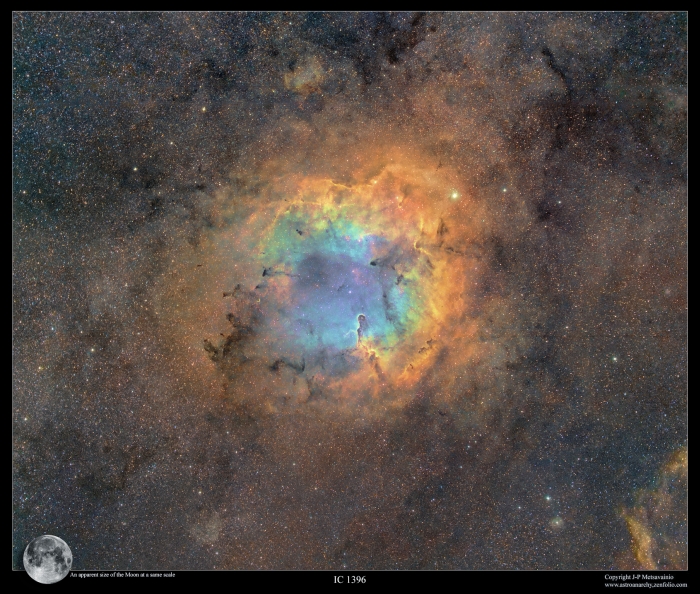
Posted on 03/19/2021 7:59:58 AM PDT by Red Badger

Have you ever thought to yourself, "Gosh, I sure wish I could feel extremely small and awed right now"? Do we ever have the solution for you!
After over a decade of painstaking work, Finnish astrophotographer J-P Metsavainio has released an absolutely jaw-dropping 1.7-gigapixel mosaic of the plane of the Milky Way galaxy.
Metsavainio has been publishing his astrophotography online since 2007, but his work on the mosaic started in 2009, with photographing various nebulae around the Milky Way as independent compositions.
The total exposure time between 2009 and 2021 is around 1,250 hours. (To load the full image in its 11.5 MB glory, click here.)
https://1.bp.blogspot.com/-TqRxEAjrDYI/YFCLF-H8K3I/AAAAAAAAS-E/rj_avOwDgw0TP66RQURSDcDIOPPxJIscgCLcBGAsYHQ/s7023/000-GrandeMosaic120DegreesLONG.jpg
"It took almost twelve years to finalize this mosaic image," Metsavainio wrote on his blog, Astro Anarchy.
"The reason for a long time period is naturally the size of the mosaic and the fact that the image is very deep. Another reason is that I have shot most of the mosaic frames as individual compositions and publish them as independent artworks.
"That leads to a kind of complex image set which is partly overlapping with a lot of unimaged areas between and around frames. I have shot the missing data now and then during the years and last year I was able to publish many sub mosaic images as I got them ready first."
Stitching the images together was a matter of matching stars and overlaying them in Photoshop, with minor tweaking between the frames to match color balance and light curves, he explained.
The resulting image is around 100,000 pixels across, made up of 234 individual mosaic panels, covering an area of sky 125 by 22 degrees.

That's a significant swathe of the galactic plane, including about 20 million stars, and the full-size color image measuring 7,000 by 1,300 pixels is truly jaw-dropping. The colors you see represent the emission from ionized elements; hydrogen is shown in green, sulfur in red, and oxygen in blue.
"I think this is the first image ever showing the Milky Way in this resolution and depth at all three color channels," Metsavainio told photography website PetaPixel.

mosaic nebula (© J-P Metsavainio)
It makes for a magnificently dazzling view of our home galaxy, and one that we can't help but get lost in. If you are not sure where to start, or would like to know more about what you're looking at, Metsavainio has helpfully posted a series of frames from the mosaic on his blog, showcasing individual nebulae.
We can also most heartily recommend visiting his portfolio to take an awe-inspiring stroll through his body of work. His 3D animations of nebulae in particular will absolutely fill you with fernweh for interstellar space travel.
The total exposure time between 2009 and 2021 is around 1,250 hours. (To load the full image in its 11.5 MB glory, click here.)
Meh. I survived the Total Perspective Vortex.
It is amazing to load the entire image and look at detail using the magnifying glass.
My God is an Awesome God
Makes us feel tiny within our Milky Way.
Yet, the Milky Way is a very tiny part of what we know as the universe.
My dog is the center of my universe, and don’t tell her otherwise!
Amen.
Man’s hubris. We can’t imagine anything bigger or better than us.
Amen.
Midwatch, 1950s USN in the Caribbean.
I climbed up into the shears for my lookout stint. Quick 180 degree scan - nothing - PITCH black.
I looked up and was stunned. From horizon to horizon, the sky was FILTHY with stars - could barely see any black behind them.
Here I am, one insignificant piece of protoplasm in a tiny boat is the middle of a big ocean on a small planet amidst all this jaw-dropping magnificence.
My ego took a big hit that night.
People living in cities or areas without an unobstructed high altitude view can never appreciate the awesome nature of the Milky Way.
I was in my 30s on a road trip in Colorado, camping out along the way. At 8,000 feet it was cold even in the summer but the view of the Milky Way was jaw dropping magnificent. If you have never seen it with an unobstructed view at a high altitude, you owe it to yourself, if only once in your life, to appreciate God’s universe.
I missed the “You are here” pointer... ha ha ha
How Great Thou Art
Songwriters
Stuart K. Hine
Published by
Manna Music
O Lord my God, When I in awesome wonder,
Consider all the worlds Thy Hands have made;
I see the stars, I hear the rolling thunder,
Thy power throughout the universe displayed.
Chorus:
Then sings my soul, My Saviour God, to Thee,
How great Thou art, How great Thou art.
Then sings my soul, My Saviour God, to Thee,
How great Thou art, How great Thou art!
When through the woods, and forest glades I wander,
And hear the birds sing sweetly in the trees.
When I look down, from lofty mountain grandeur
And see the brook, and feel the gentle breeze.
Then sings my soul, My Saviour God, to Thee,
How great Thou art, How great Thou art.
Then sings my soul, My Saviour God, to Thee,
How great Thou art, How great Thou art!
And when I think, that God, His Son not sparing;
Sent Him to die, I scarce can take it in;
That on a Cross, my burdens gladly bearing,
He bled and died to take away my sin.
Then sings my soul, My Saviour God, to Thee,
How great Thou art, How great Thou art.
Then sings my soul, My Saviour God, to Thee,
How great Thou art, How great Thou art!
When Christ shall come, with shout of acclamation,
And take me home, what joy shall fill my heart.
Then I shall bow, in humble adoration,
And then proclaim: “My God, how great Thou art!”
Then sings my soul, My Saviour God, to Thee,
How great Thou art, How great Thou art.
Then sings my soul, My Saviour God, to Thee,
How great Thou art, How great Thou art!
The Story Behind How Great Thou Art
Stuart K. Hine was a Bristish Methodist missionary on a mission trip in Ukraine in 1931 when he heard the Russian translation of a German song inspired by Carl Boberg’s poem “O Store Gud” (O Great God). Hine began to translation the song to English and added several verses. The third verse was inspired by the conversion of villagers in Russia who cried out to God loudly as the repented and realized God’s love and mercy - “And when I think that God, His Son not sparing, sent Him to die, I scarce can take it in.”
Stuart Hine and his family left Ukraine as famine and World War Two began, and settled in Somerset, Britain where he continued to serve as a missionary to Polish refugees. The forth verse of “How Great Thou Art” was inspired by displaced Russians who experienced great loss and looked forward to seeing their loved ones again in heaven - “When Christ shall come with shoult of acclamation to take me home, what joy shall fill my heart.”
The final English version of “How Great Thou Art” was published in 1949 and quickly spread among Britian, Africa, India and America.
ping
When I look at the Milky Way I see a bunch of stars, some first magnitude. This picture is mostly illuminated “smoke”. Why the difference. If the smoke is because of the gathering of more light then the stars ought to be correspondingly brighter.
Also, I’ve see picture of celestial objects in which there was more redness.
Thanks! Made it one of my wallpapers.
The very first time I experienced total blackness like that was on a road trip to Idaho right after my 1973 college graduation in Missouri. My buddy and I headed up along the Green River / Flaming Gorge at the Utah / Wyoming border at midnight. I stopped the car and looked around 360 degrees and there was not a single man-made light visible anywhere and no glow of any cities over that 360 degree horizon. It was astonishing and absolutely breathtaking.
Many variables involved: Type of film, speed of film, if film is even used, exposure, lens, filters, aperture, et al..................
Disclaimer: Opinions posted on Free Republic are those of the individual posters and do not necessarily represent the opinion of Free Republic or its management. All materials posted herein are protected by copyright law and the exemption for fair use of copyrighted works.